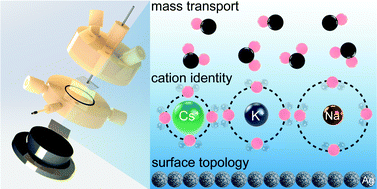Resolving local reaction environment toward an optimized CO2-to-CO conversion performance†
Abstract
The local reaction environment, especially the electrode–electrolyte interface and the relevant hydrodynamic boundary layer in the vicinity of the cathode, plays a vital role in defining the activity and selectivity of the electrochemical CO2 reduction reaction. Here, we present a differential electrochemical mass spectroscopic (DEMS) approach on the Ag electrode to resolve this information and provide hints for optimized CO2-to-CO conversion performance. A multi-physics model with computational fluid dynamics and chemical simulation is firstly proposed to demonstrate the flow pattern and the CO2 distribution within the cathodic DEMS chamber under operational conditions. Using this developed spectroelectrochemical method, we investigate the promotion effects of CO2 mass transport, cation identity and surface topology on Ag catalyzed CO2 reduction at a temporal resolution of ∼200 ms. As a proof of concept, these fundamental understandings have been validated in a pilot anion exchange membrane electrolyzer, leading to a CO partial current density above 650 mA cm−2 at 4.0 V, an operational voltage window wider than 1.0 V and a stable CO generation for 100 hours at 500 mA cm−2 for CO selectivity above 80%.



 Please wait while we load your content...
Please wait while we load your content...